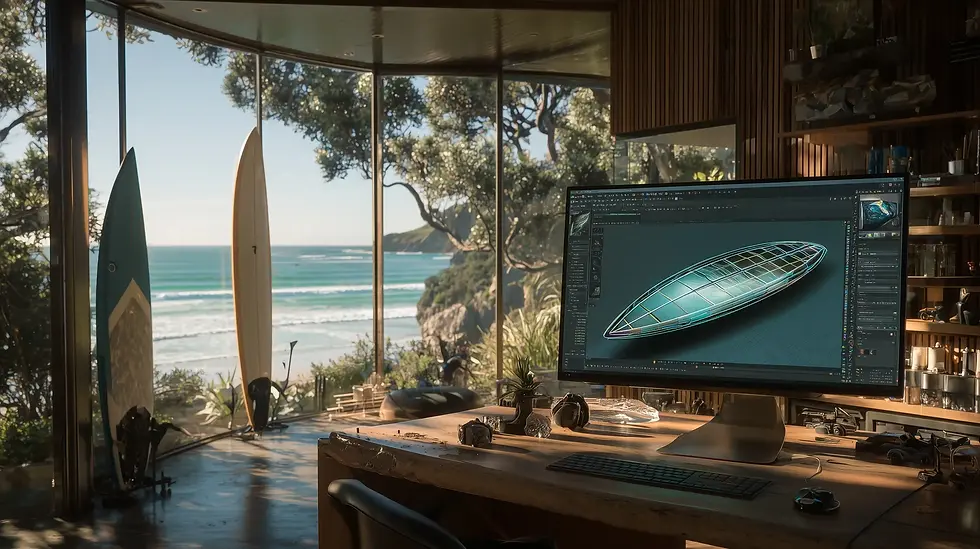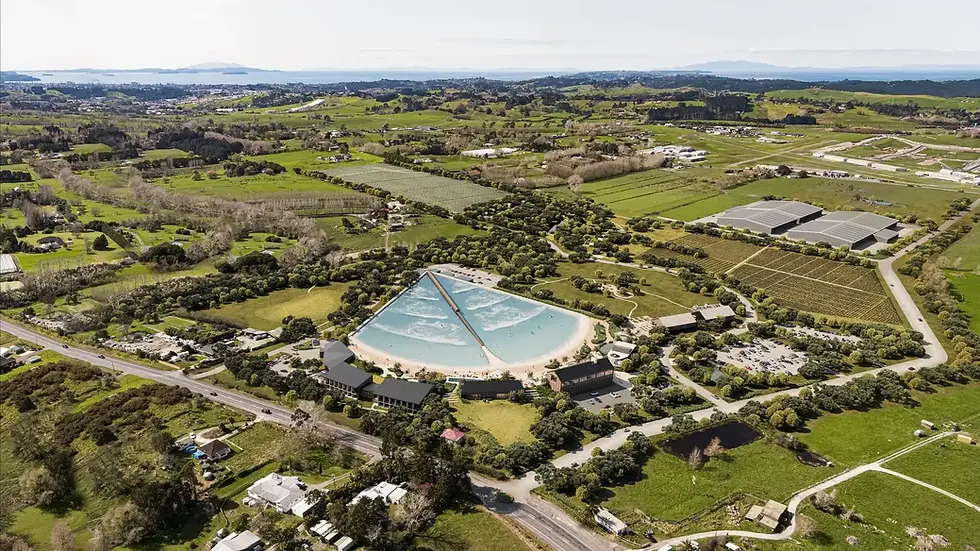The Rise of Smart & Eco Surfboards
- Team MEGA

- Sep 16
- 4 min read
For most of surfing’s history, boards haven’t really changed. Sure, there have been tweaks in shapes, sizes, and fins, but the guts of a board – foam, fibreglass, resin – have been the same for decades.
Now though, things are moving. Not just because of performance, but because of two big drivers: the environment and technology.
Surfers like to talk about being ocean lovers, but the boards we’ve been riding are anything but clean. And while most of us are happy with wax, fins, and foam, there’s a new crowd pushing data, sensors, and even electric power into surfing. The big question is: what’s actually useful, and what’s just hype?

PU and Fibreglass
Most boards you see on a beach in New Zealand today are still built the old way:
Polyurethane foam (PU) core – lightweight but non-recyclable.
Fibreglass cloth – wrapped around the blank.
Polyester or epoxy resin – hardens the lot.
That combination works. It’s why shortboards are light, responsive, and easy to shape. But it’s also a dirty industry. The dust from shaping is toxic, the resins are full of chemicals, and broken boards usually end up in the landfill.
The average shortboard might only last 2–3 years before it’s creased or snapped. Multiply that by millions of surfers worldwide, and you’ve got a mountain of foam and fibreglass waste.
Eco Boards
This is where eco boards come in. Around the world, shapers are experimenting with different materials to cut down the waste.
Recycled Foam: Old boards are shredded down and used to create new blanks. Not perfect, but it closes the loop a little.
Algae Foam: Companies are testing algae-based foams that act like PU but break down naturally.
Hemp Cloth: Swapping out fibreglass for woven hemp gives similar strength, with less impact.
Bio Resins: Plant-based resins that cure like polyester, but without as many harmful chemicals.
Surfers don’t want boards that feel heavy, bend like sponges, or snap on the first wipe-out. Some eco boards have nailed it. Others feel like you’re dragging a fridge out in the surf.

Smart Boards: Surfing Meets Tech
On the other end of the spectrum, you’ve got smart surfboards. Think about snowboards and bikes – sensors, trackers, apps. Surfing’s heading there too.
Embedded Sensors: Chips in the board track speed, angle, turns, and time on wave.
AR Training: Some prototypes connect to goggles or phones to show your technique in real time.
Electric Surfboards: These are already here – battery-powered boards that let you ride even on flat days. Popular in lakes and harbours.
Wave Counting & GPS: Handy for training or bragging rights – “I got 27 waves this session.”
For pros, the data is gold. Coaches can break down exactly how a surfer’s turning, where they’re losing speed, what angle they’re hitting. For everyday Kiwis? It’s a mixed bag. Some reckon it’s brilliant for learning. Others say it kills the whole point – surfing’s meant to be about flow, not numbers on a screen.
Overseas, brands are throwing serious money at this. Big surf companies are betting on two parallel futures: greener boards and smarter boards. Patagonia’s already producing wetsuits out of natural rubber (Yulex), and they’re backing eco board tech too. Start-ups in the U.S. and Europe are rolling out recycled blanks, and even 3D-printed boards.
Some of these will flop. Surfers aren’t kind to gear that doesn’t perform. But some will stick, especially if they’re cost-competitive. The big challenge is that surfers expect boards to be both light and strong. That’s tough to deliver with eco materials that are usually heavier.

What Surfers Really Think
Let’s be honest – surfers are split.
The Old Guard: If it’s not PU and fibreglass, they don’t trust it.
The Groms: More open, especially to eco boards.
The Tech Heads: Keen on sensors and electric boards, but they’re still a minority.
The Weekend Warriors: Don’t really care, as long as the board works and doesn’t cost the earth.
The market will probably follow a middle road. Eco boards will slowly become normal, especially as costs come down. Smart boards will find a niche, maybe in surf schools or training environments. But you’re still going to see plenty of good old fibreglass boards on the beach for years to come.
The Future of Surfboards
So where are we heading?
Eco will win in the long run. Just like plastic bags and petrol cars, the pressure to move away from toxic materials is only going to grow.
Smart will be optional. Some people will love it, some will ignore it. It won’t replace the feel of surfing – it’ll just be a tool for those who want it.
Customisation will explode. 3D printing, AI design tools (behind the scenes, not cheesy marketing), and local shapers experimenting will mean more choice.
Second-hand will stay strong. In NZ, especially, surfers will keep swapping boards around, fixing dings, and riding them till they snap.
At the end of the day, boards are tools. The ride matters more than the label. But if tomorrow’s boards can keep the stoke alive while being kinder to the planet – or even just help a grom figure out their pop-up – then maybe the future’s worth watching.
Team MEGA!








Comments